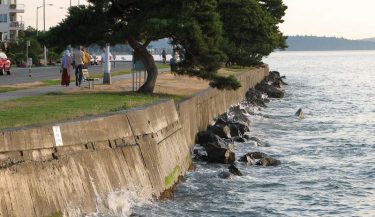
Bulkheads and seawalls along the shores of Puget Sound help ease erosion and stabilize bluffs to protect waterfront properties.
But these walled structures also shrink beaches, reduce habitat for invertebrates and spawning fish and, indirectly, degrade conditions for iconic species like salmon and orcas. Many studies have shown this pattern at seawall sites around Puget Sound.
A new University of Washington study shows that impacts at individual armored sites can scale up to have cumulative, large-scale effects on the characteristics of Salish Sea shorelines and the diversity of life they support. It is the first study to analyze sites broadly within Puget Sound and offers the most comprehensive look to date at the impacts of shoreline armoring on the Salish Sea ecosystem.
“Given the incredible variety and complexity of shorelines in the Salish Sea, to pick out patterns we had to go very broad and step back and squint, if you will,” said lead author Megan Dethier, a research professor of biology at the UW’s Friday Harbor Laboratories.
Read more at UW Today »
